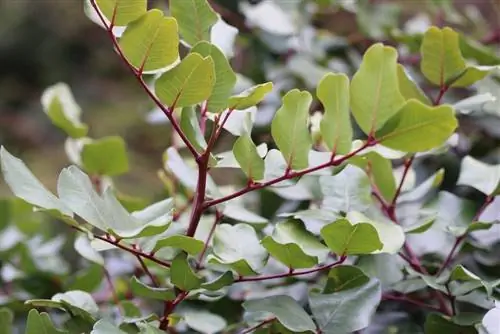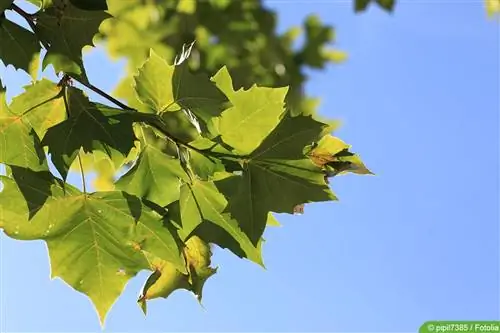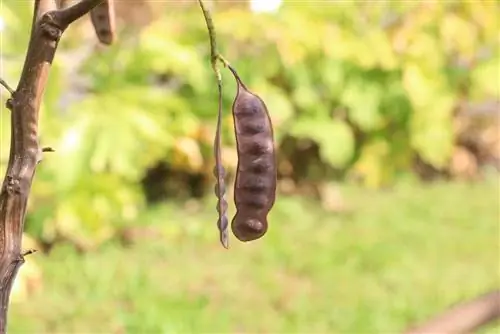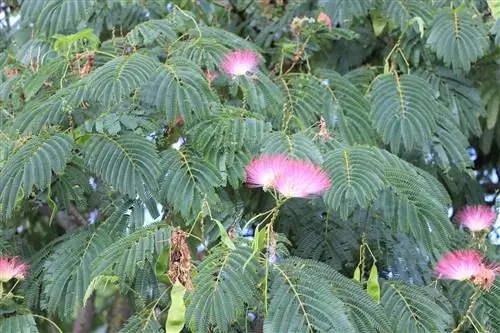- Author admin [email protected].
- Public 2023-12-17 03:39.
- Last modified 2025-01-24 12:45.
Everyone has probably heard of the carob tree. It can be planted in Central European gardens. However, it is advisable to familiarize yourself with the characteristics and requirements of the carob tree in order to ensure the greatest possible success when planting.
Requirements for cultivation
Due to its origins, the carob tree is sensitive to frost, especially when young. However, it can be grown all year round in a warm place in the home as a container plant or in the winter garden. The germination temperature is 20-25°C, and after a few years it can withstand temperatures of 5°C well in winter. You don't necessarily have to be a gardening expert to grow this tree yourself, because apart from its sensitivity to cold and its hypersensitivity to waterlogging, you don't have to take much into account when growing and caring for this plant.
cultivation
- The carob tree is easy to grow from the lenticular, brown seeds, which can either be bought commercially or brought back from vacation in sunnier climes.
- It is advisable to first soak the seeds in water for a day before allowing them to germinate in a seed pot in a warm place.
- To do this, cover them with approx. 3 to 10 mm of potting soil and keep the seeds moist in a warm, partially shaded location for about 20 days until they have germinated. In exceptional cases, germination can take significantly longer.
- Cultivating soil for cacti, but also any other predominantly permeable, calcareous substrate can be used, as the carob tree does not place great demands on the soil.
After germination
Approximately 3 to 6 weeks after germination, when the second pair of leaves has fully developed after the cotyledons, the seedling must be carefully repotted to give the long taproot that it has already developed enough space. The carob tree can then move to a sunny location in order to carry out sufficient photosynthesis for further development. In a large pot the tree grows much faster and stronger.
Care
Locations
In the spring after the last frosts and in the autumn before the first frosts, the tree likes to be sunny to partially shaded, although after the winter you should slowly get it used to the full sun, otherwise it can get sunburnt. If, despite all caution, some leaves burn, they can be removed and the remaining leaves are usually he althy. In winter it can be either semi-dark at around 5°C or sunny at room temperature. In a sunny location it continues to grow taller during the winter break; when it is darker over the winter the trunk becomes stronger.
Water and nutrient requirements
The carob tree only needs to be watered occasionally after the initial phase and can also tolerate drought well from time to time. In any case, waterlogging should be avoided, otherwise it will become moldy. It is used to poor soil, but still appreciates fertilization once or twice during the growing season in spring and summer. Any flower or garden fertilizer can be used as fertilizer.
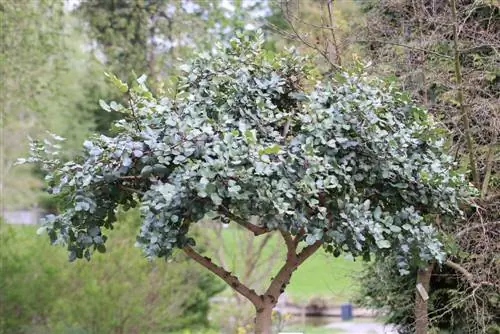
Tree cutting
The carob tree can be grown as a bonsai or as a container plant, and in warm places such as a spacious and high winter garden it can also be grown as a standard solitaire. Tree pruning also looks different depending on the type of culture. To achieve a beautiful, bushy treetop, you can cut this hardwood tree into shape after the winter break or at other times of the year. To achieve a bushy, not-too-tall result, you can also trim the tree. When young, the carob tree tends to have a thin trunk and slender shoots. Only over the years does it become gnarlier and more stable. This can be encouraged by annual pruning.
Repotting the carob tree
To grow a beautiful, strong tree, you should give it a larger pot about every 1-2 years so that it can continue to develop. In southern countries, the tree grows up to 20 meters high in freedom. If there is not a lot of space available for the pot, the carob tree will be satisfied with less.
Pests and diseases
In general, pests are not observed very often on this legume crop, but aphid infestations can occur on young trees in spring. If this is noticed in time, the lice can be collected or rinsed off. If this is not possible, insecticides or plant protection sticks can be used. Biological, environmentally friendly beneficial insects against aphids include: E.g. ladybirds, flower bugs or gall midges. Increasing the humidity or chemical agents can help against scale insects, mealybugs and mealybugs that appear from time to time.
As a biological alternative to chemicals, the tree can be sprayed with a spirit soap solution or a mineral oil mixture. Natural enemies of these lice are the lacewing, the ladybird and the parasitic wasp. The lice infestation must be treated in any case, as the honeydew excreted by the lice can promote the formation of fungal diseases.
Profile
- Appearance: evergreen tree with paired, leathery leaves that initially sprout in a reddish color, flowering of stiff, yellow-red grapes in winter
- Use: as a potted plant, bonsai or tree in the winter garden
- Growing: from seeds, germination temperature 20-25 °C, prick out, later repot from time to time
- Location: sunny to partially shaded
- Requirements: no frost, water regularly but not too much, permeable soil, low nutrient requirements
- Overwintering: no problem in a frost-free place, older trees resistant to -5 °C
- Care errors: waterlogging, frost
- Cropping: not mandatory, but possible at any time
What you should know in brief
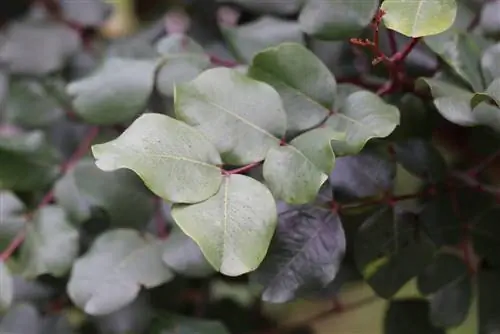
This beautiful tree is suitable for cultivation not only by professionals, but also for plant lovers with a less green thumb. It is versatile, requires little care and is almost indestructible. A very grateful plant for gardening beginners and professionals. However, the carob tree is also used economically: the well-known carob gum is made from the seeds. The seeds are hard, shiny kernels that are contained in pods. The flour obtained is used in confectionery, puddings, ice cream and sauces. Products containing this flour are also consumed for dietary purposes, for diarrheal diseases and obesity, and also for baby food.
- The tree has small pinnate leaves that are shiny green on the top and red-brown on the underside.
- The leather-like surface of the leaves allows the carob tree to store its water reserves for a very long time and prevents evaporation.
- The tree bears butterfly flowers, which are very inconspicuous and smell unpleasant. The flowering period lasts from May to September.
- The flowers produce legumes that can grow to an astonishing 30 cm long. The fruits are ripe after about a year.
- Their pulp is initially soft and sweet, then later hard and has a very long shelf life. The dark red to black pods are harvested in September.
- Especially in rural areas, these fruits are eaten fresh or made into syrup. Alcohol and honey are also produced.
- The pulp is also processed into powder. This is similar to common cocoa and has a very high sugar content and is very low in fat. It will last for several years in sealed containers.
- There are many economic reasons to plant this tree and preserve its species. In addition to food and medicine, wood is also extracted. Since it is very resistant to any kind of rotting, fences, parquet and tool handles are made from the wood.
- The carob tree also has soil-strengthening properties in coastal areas, shade-providing properties when the sun is shining and food-providing properties for animals of all kinds. It would be a shame if this tree no longer existed.
- But there are also places that revere the carob tree as an ornamental plant, so in Arizona and California many of its kind are simply used to decorate the city and to provide shade.

